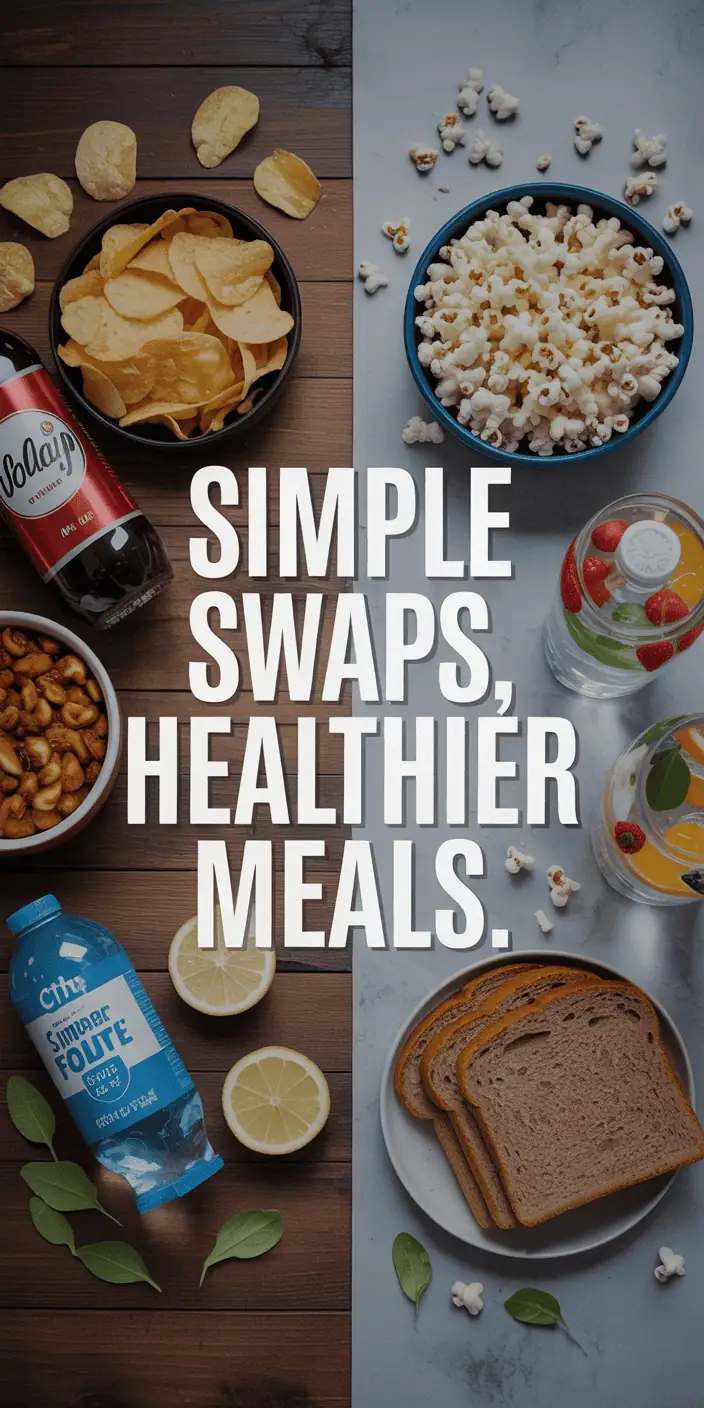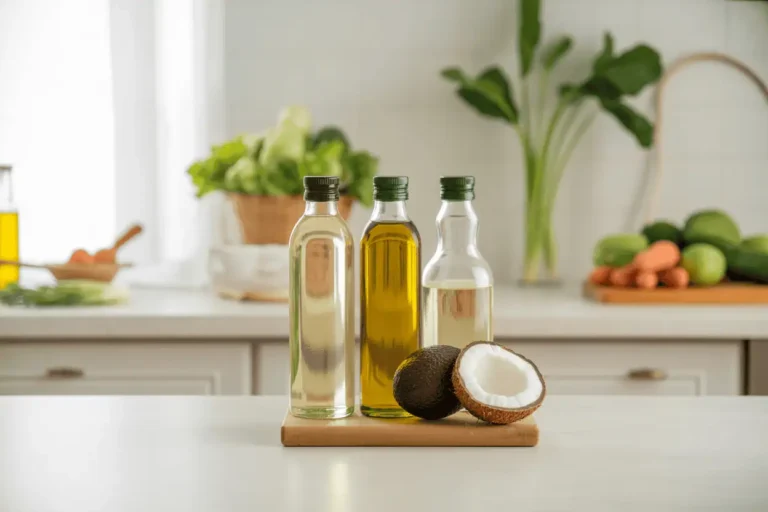Simple Food Swaps That Make Everyday Meals Healthier
Key Takeaway: You don’t need to overhaul your entire diet to eat better. With just a few strategic swaps in foods you already eat, you can dramatically improve your nutrition without sacrificing taste or convenience.
Most nutrition advice feels like it’s written for people who have unlimited time, money, and willpower. Switch to quinoa! Buy organic everything! Meal prep for three hours every Sunday! But here’s what I’ve learned after years of trying to eat better while juggling real life: the biggest improvements come from the smallest changes.
The truth is, you’re probably already eating pretty well most of the time. You just need to upgrade a few key players in your regular rotation. Think of it like updating your phone—same basic functions, but everything works better.
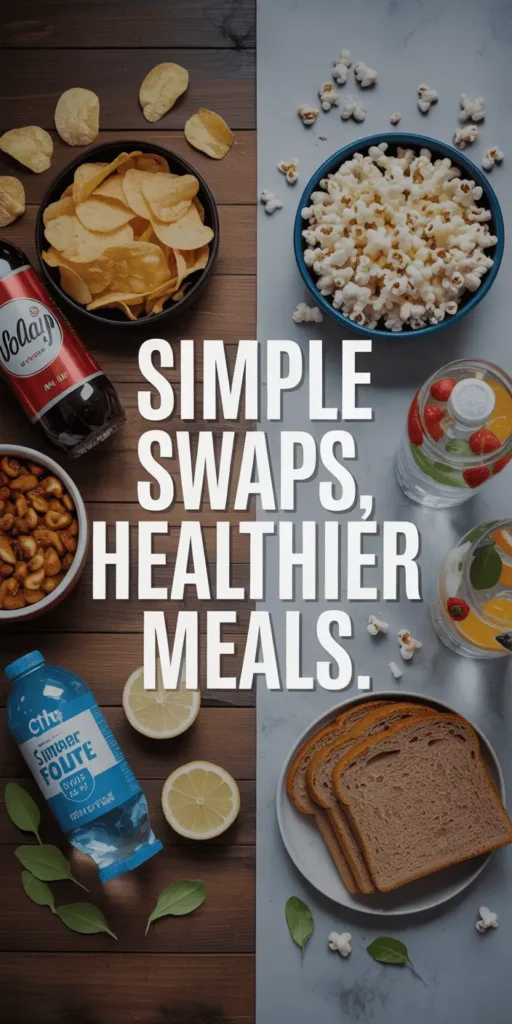
Why Simple Swaps Actually Work
Here’s the thing about dramatic diet overhauls: they don’t stick. Research shows that people who make small, sustainable changes are way more likely to maintain them long-term than those who try to change everything at once.
The psychology is simple: When you swap white bread for whole grain bread, you’re still eating a sandwich. Your brain doesn’t register it as “dieting” or deprivation. You’re just eating a slightly different version of what you already enjoy.
The nutrition is powerful: Even basic swaps can address the biggest nutritional gaps in the American diet. We’re talking about the stuff that actually matters—too much sodium (89% of us get too much), not enough fiber (most of us get about half of what we need), and way too many ultra-processed foods.

Figure: The nutritional impact of simple food swaps across different meal categories—showing how small changes create significant improvements in key nutrients
What the data shows: Making just five strategic food swaps can give you nearly 24% of your daily fiber target and reduce your sodium intake by almost 10% of the daily limit. That’s not small potatoes—that’s the kind of change that actually impacts how you feel.
The Game-Changing Swaps by Meal
Let’s get practical. Here are the swaps that give you the biggest nutritional bang for your buck, organized by when you’d actually eat them.
Breakfast: The Foundation Swap

Instead of sugary cereal → Steel-cut oats
I know, I know. Oats sound boring. But hear me out—steel-cut oats have a completely different texture than the mushy stuff you might remember from childhood. They’re chewy, almost nutty, and they keep you full until lunch.
The numbers: This single swap increases your fiber intake by 606% and reduces sodium by 92%. That’s not a typo.
Make it work: Cook a big batch on Sunday (they reheat perfectly), or try overnight oats if you’re not a morning person. Add whatever makes you happy—berries, nuts, a drizzle of maple syrup. The goal is eating it, not winning a health food contest.
Real-world tip: I started mixing steel-cut oats half-and-half with my regular cereal. After a few weeks, I didn’t miss the sugary stuff at all.
Lunch: The Protein Upgrade

Instead of processed deli meat → Grilled chicken breast
Deli meat is convenient, but it’s also loaded with sodium and preservatives. Grilled chicken gives you 140% more protein and 92% less sodium.
Make it practical: Grill or bake several chicken breasts on Sunday, slice them up, and store in the fridge. They’ll last all week and work in sandwiches, salads, or grain bowls.
Flavor hack: Season the chicken with whatever spice blend you love. I rotate between everything bagel seasoning, Italian herbs, and a simple salt-pepper-garlic combo.
Dinner: The Satisfying Switch
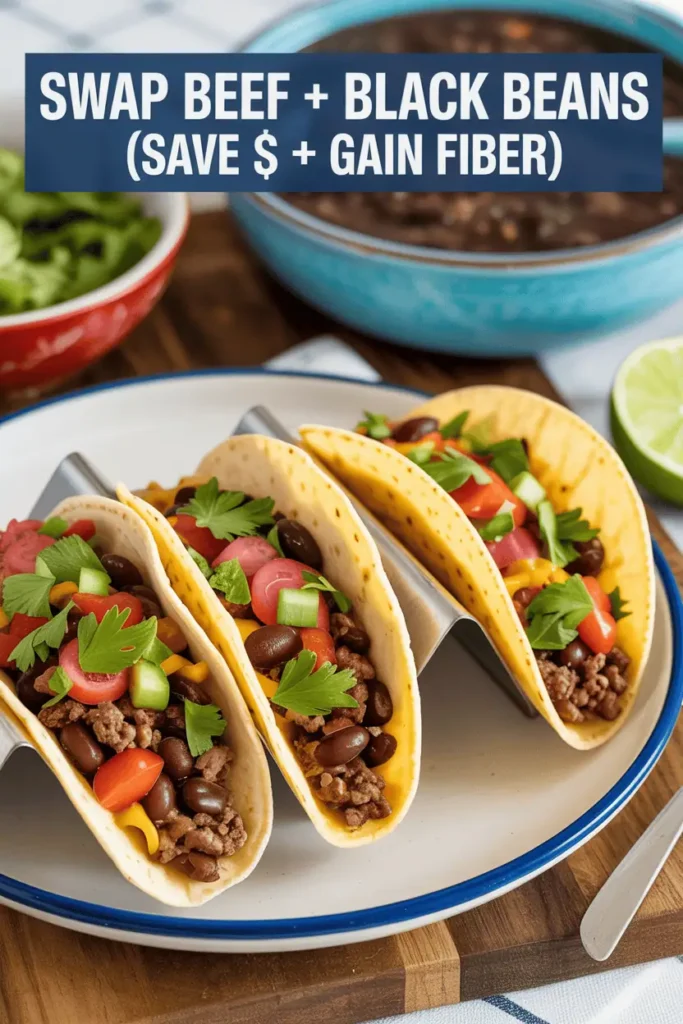
Instead of ground beef → Black beans
Before you roll your eyes, let me explain. I’m not saying never eat beef again. I’m saying that swapping it out once or twice a week for black beans gives you 100% more fiber, 93% less sodium, and saves you money.
The taste factor: Black beans are incredibly versatile. They work in tacos, pasta sauce, grain bowls, and even burgers. Season them well, and they’re just as satisfying as meat.
Practical approach: Keep canned black beans in your pantry. Rinse them (this removes about 40% of the sodium), then season with cumin, garlic powder, and a splash of lime juice.
Snacks: The Crunch Factor
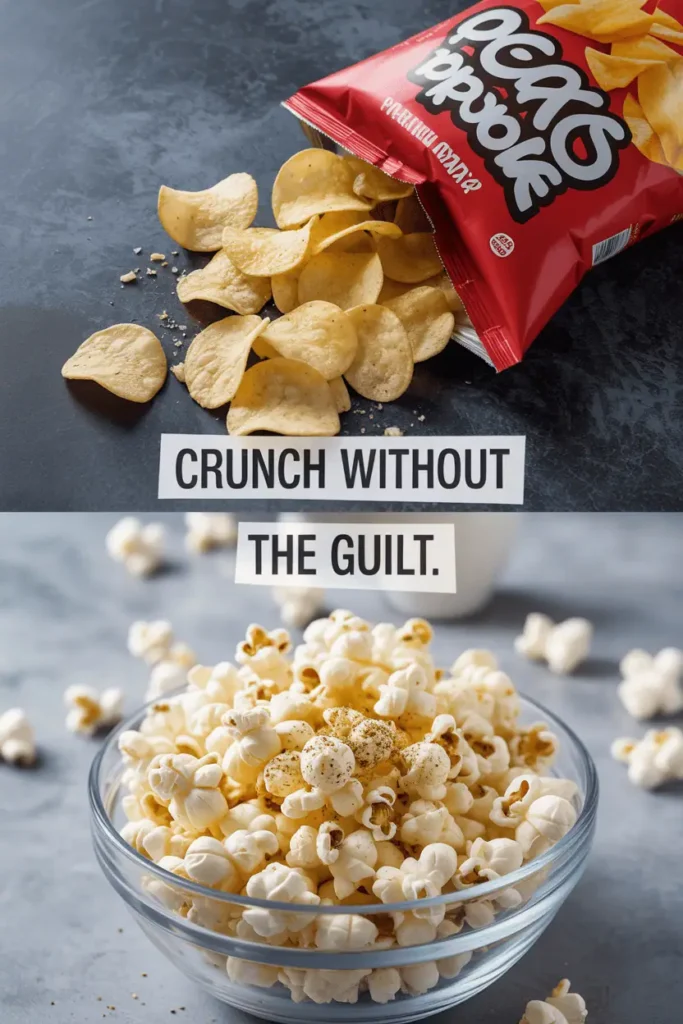
Instead of potato chips → Air-popped popcorn
This swap gives you 387% more fiber and 98% less sodium while still satisfying that need for something crunchy and salty.
The key: Good seasoning. Plain popcorn is sad popcorn. Try nutritional yeast for a cheesy flavor, everything bagel seasoning, or even a light sprinkle of parmesan.
Budget win: Air-popped popcorn costs about a third of what you’d pay for chips, and it’s way more filling.
The Stealth Swaps That Change Everything
These are the swaps that fly under the radar but make a huge difference in how your food tastes and how you feel.
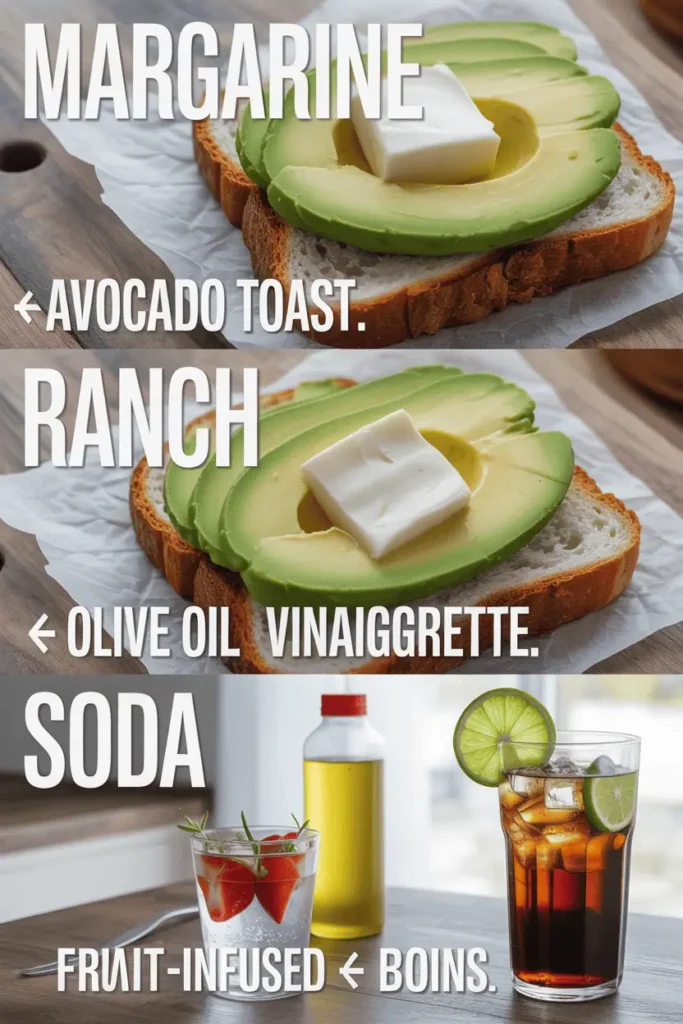
The Fat That Actually Helps
Instead of margarine → Avocado
This is the swap with the highest nutritional impact score in our analysis. Avocado gives you 9,600% more potassium (yes, that’s the real number) and 99% less sodium than margarine.
How to use it: Mash half an avocado with a fork, add a pinch of salt and lemon juice, and spread it on toast. It’s creamier than butter and way more nutritious.
Storage tip: Buy avocados at different stages of ripeness so you always have one ready. Store ripe ones in the fridge—they’ll last another 3-4 days.
The Condiment Game-Changer
Instead of ranch dressing → Olive oil vinaigrette
Ranch is basically mayonnaise with herbs, which means it’s high in calories and sodium but low in actual nutrition. A simple vinaigrette gives you healthy fats and 82% less sodium.
The 2-minute version: Mix 3 parts olive oil to 1 part vinegar (any kind), add a pinch of salt, pepper, and whatever herbs you have. Shake it up in a jar and it keeps for weeks.
Flavor variations: Balsamic and olive oil is classic, but try apple cider vinegar with Dijon mustard, or lemon juice with garlic and oregano.
The Beverage Baseline
Instead of soda → Water (with a twist)
This one’s obvious but worth mentioning because the impact is huge—100% calorie reduction and 100% sodium reduction.
Make it interesting: Add sliced cucumber, berries, or herbs to plain water. Sparkling water with a splash of 100% fruit juice gives you the fizz without all the sugar.
The transition strategy: If you’re a heavy soda drinker, try cutting it in half first. Replace every other soda with flavored sparkling water, then gradually shift the ratio.
Making Swaps That Actually Stick
Here’s where most people mess up: they try to change everything at once, get overwhelmed, and give up. The key is making swaps that feel natural, not forced.
The Similarity Principle
Choose swaps that match the original food’s taste and texture. Your brain is more likely to accept a swap if it’s similar to what you’re replacing. Whole grain bread instead of white bread works because it’s still bread. Trying to replace bread with lettuce wraps? That’s a harder sell.
Examples that work:
- Greek yogurt instead of sour cream (both creamy and tangy)
- Brown rice instead of white rice (same texture, nuttier flavor)
- Sparkling water instead of soda (still fizzy and refreshing)
The One-at-a-Time Rule
Pick one swap and stick with it for two weeks before adding another. This gives your taste buds time to adjust and your brain time to form a new habit.
Week 1-2: Focus on just the bread swap
Week 3-4: Add the beverage swap
Week 5-6: Try the snack swap
Why this works: You’re not overwhelming yourself with changes, and each swap becomes automatic before you add the next one.
The 80/20 Approach
You don’t have to make the swap every single time. Aim for 80% of the time, and don’t stress about the other 20%.
Real example: I buy whole grain bread for home but don’t worry about it when I’m eating out. The goal is progress, not perfection.
The Nutritional Impact That Actually Matters
Let’s talk numbers for a second, because the impact of these swaps is pretty impressive when you add them up.
If You Made Just the Top 5 Swaps:
Daily fiber increase: 5.9 grams (that’s 24% of your daily target)
Daily sodium reduction: 215 mg (9% less than the daily limit)
Daily calorie reduction: 149 calories (without feeling deprived)
What this means: You’d be getting significantly more of the nutrients most Americans lack (fiber, potassium) and significantly less of what we get too much of (sodium, empty calories).
The Population-Level Impact
Here’s something wild: if just 25% of American adults made these five swaps, we’d collectively reduce our daily sodium intake by 14 tons. That’s the kind of change that could actually impact public health.
The point: Your individual choices matter, but they also add up to something bigger.
Common Swap Challenges (and Friendly Fixes)
Small changes stick best. If a swap feels tricky, try these calm, practical tweaks—no perfection required.
“It doesn’t taste the same”
- Cook brown rice in broth instead of water.
- Toast whole-grain bread and add your favorite toppings.
- Use spice blends (everything bagel, taco, curry) to wake up flavor.
“It’s more expensive”
“I don’t have time for this”
“My family won’t eat it”
- Whole-grain pasta (sauced, most can’t tell).
- 50/50 ground beef + black beans in tacos.
- Let kids pick the seasoning or toppings.
Need more quick wins?
Try one swap for two weeks before adding another. Aim for 80/20—progress beats perfection.
Your Simple Starting Point
Feeling overwhelmed? Don’t be. Here’s your action plan:
This Week:
Pick one swap from this list and try it three times. That’s it. Don’t worry about anything else.
Next Week:
If the first swap is working, add a second one. If not, try a different swap from the same category.
Month Two:
Once you’ve got 2-3 swaps that feel automatic, you can experiment with others or just stick with what’s working.
The Long Game:
After a few months, these swaps won’t feel like swaps anymore—they’ll just be what you eat. That’s when you know you’ve made a real change.
The Bottom Line
You don’t need to eat perfectly to eat well. You don’t need to spend a fortune or hours in the kitchen. You just need to make a few smart swaps in foods you’re already eating.
The beauty of this approach: You’re not adding complexity to your life—you’re just upgrading what you’re already doing. Same sandwich, better bread. Same snack time, better snack. Same cooking routine, better ingredients.
The real win: These aren’t temporary changes you’ll abandon when life gets busy. They’re sustainable improvements that become part of your normal routine.
Your new mantra: “Progress, not perfection.” Every swap you make is a win, even if you don’t make them all. Start where you are, use what you have, do what you can.
Pick one swap from this article and try it this week. Just one. Your future self will thank you for every small step you take toward eating a little bit better, without all the stress and complexity that usually comes with “healthy eating.”
You’ve got this. And the best part? You don’t need to change everything to change something important.

